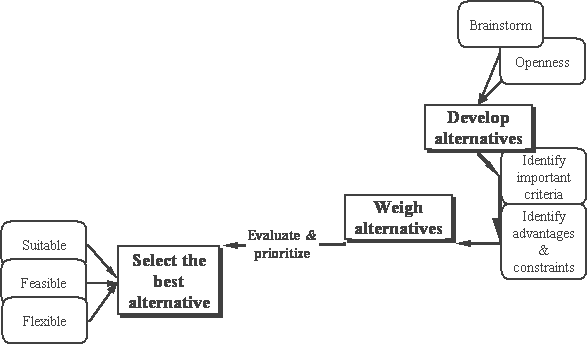Kiosk
History teaches us that men and nations behave wisely
once they have exhausted all other alternatives.
Abba Eban, 1915 - 2002
Israeli diplomat |
Problem solving series
2. Developing/weighing alternatives
Look at your problems in different ways; find a new
perspective that you haven't thought of before.
Brainstorming, or rapid noting of alternatives no matter how
silly, is an excellent discovery process.
Once you have listed or mapped alternatives, be open to their
possibilities. Make notes on those that:
- need more information
- are new solutions
- can be combined or eliminated
- will meet opposition
- seem promising or exciting
Weigh Alternatives
After listing possible alternatives,
evaluate them
without prejudice,
no matter how appealing or
distasteful
Consider all criteria
While a suitable solution
may solve the problem, it may not work if resources aren't
available, if people won't accept it, or if it causes new
problems

Select the best alternative
- Don't consider any alternative as "perfect
solution."
If there were, there probably wouldn't be a problem in the first place - Consider your intuition,
or inner feelings in deciding on a course of action - Return to your trusted outsider:
Is there something you missed?
Does he/she see a problem with your solution? - Compromise
Consider compromise when you have a full grasp of the problem, and your alternatives. Competing solutions may yield a hybrid solution.
Techniques in weighing alternatives:
 Thomas Saaty's Analytical Hierarchy Matrix.List alternatives in columns and rows as depicted in the matrix above. Starting with Alternative A, go across columns in the matrix and rate each alternative against all the others. |
|
When the alternative under consideration has
|
Then give the more valuable alternative a score of 1 |
|
|
|
|
When the alternative has |
give the less valuable alternative a score of 0 |
Add the scores for each row/alternative; highest score is the highest rated alternative according to the criteria you used. In the matrix above, Alternative C scores highest, so it's the highest rated alternative
SFF Matrix: Suitability, Feasibility & Flexibility
| Suitability | Feasibility | Flexibility | Total | |
| Alternative A | ||||
| Alternative B | ||||
| Alternative C | ||||
| Alternative D |
Rate each alternative onscale of 1 - 3 for its
- Suitability: refers to
the alternative itself, whether it is ethical or practical. Is it appropriate in scale or importance? an adequate response? too extreme? - Feasibility: refers to
How many resources will be needed to solve the problem (i.e. Is it affordable?)
How likely will it solve the problem? - Flexibility: refers to
your ability to respond
to unintended consequences, or openness to new possibilities? the alternative itself, and whether you can control outcomes once you begin.
Total a score for each alternative, compare, prioritize your alternatives...
 Website overview:
Kiosk guides for learning are a freely accessible educational environment that offers strategies to recognize and realize learning objectives. We accept individual differences without regard to ability and creed; sexual and affectional orientation; caste, tribal and national affiliation; individual, familial and collective history. Our suggestions should be thoughtfully considered for appropriateness and guidance to your situation, relying on elders, mentors, cohorts and/or professionals to achieve learning objectives and outcomes.
Website overview:
Kiosk guides for learning are a freely accessible educational environment that offers strategies to recognize and realize learning objectives. We accept individual differences without regard to ability and creed; sexual and affectional orientation; caste, tribal and national affiliation; individual, familial and collective history. Our suggestions should be thoughtfully considered for appropriateness and guidance to your situation, relying on elders, mentors, cohorts and/or professionals to achieve learning objectives and outcomes.